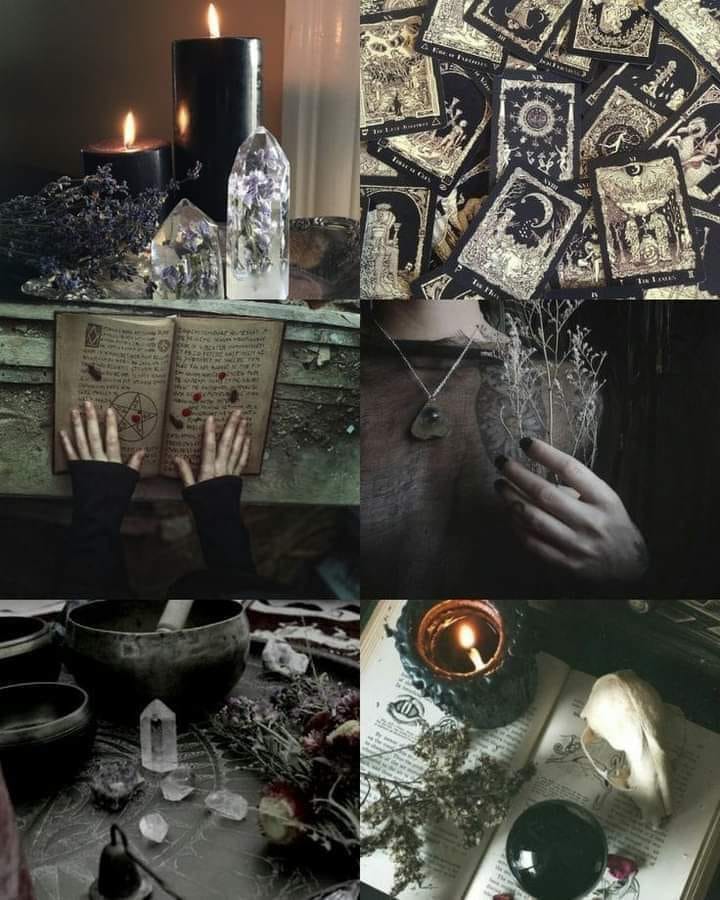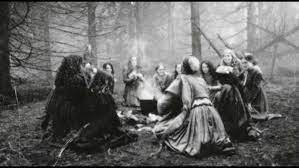
MAGICK CHANT FOR POWER AND PROTECTION
“I call upon the powerful, cosmic guardians who have the magnetic force to bring power and strength to those who believe.
I now declare and affirm that I am a living electromagnetic.
I am positive. I have a strong will.
I am fearless-absolutely fearless – nothing can harm me.
I am the master of my destiny.
I surround myself with a mental atmosphere of protection.
No harm can penetrate this positive armor.
Those would harm me shall be powerless and their “evil” shall return to them a thousand-fold.
I am strong.
I am safe.
I am positive, I am powerful.
So Mote It Be”
Home Cleansing & Home Protection Spell
To cleanse an area from malicious spirits… Smudge the area as you recite:
“Spirits that harbors ill intent,
Begone with you and never come again.
Only those with goodwill may enter & roam,
And visit this place that I call home”
Also protect your home… (You may wanna research on ways to protect your home), but here’s a simple Incantation I came up with:
Sit in a comfortable position (or in front of your Altar if you have one), close your eyes and meditate for awhile when you feel is right, you can recite:
“Lord & Lady, Hear my call,
Protect those living within these walls,
Shield my home from hex and curse,
By thy powers they shall reverse,
Shield us against All Spells of Black,
From whence they came, repel them back,
This I ask in the name of Divinity,
Work my will, So mote it be.”
After you are done thank the lord and lady:
“Lord and Lady, to thee I give thanks,
Merry meet and merry part, Until we merry meet again…”
Blessed Be
OBJECT PROTECTION SPELL
With the first and middle fingers (or your Athame, if you have it with you), trace a pentagram over the object to be protected.
Visualize electric-blue or purple flame streaming from your fingers (Athame) to form the pentagram.
Say this as you trace the pentagram:
With this pentagram I do lay
Protection here both night and day.
And to the one who should not touch
Let the fingers burn and twitch.
I now invoke the Law of Three:
This is my will, so mote it be!
Magic Book blessing Spell
Place the book on the table or altar and say:
I will serve the great Goddess
And give reverence to the great God
I am a pagan, a stone in the ancient circle
Standing firmly balanced on the earth
Yet open to the winds of heaven
And enduring through time
May the old Gods witness my words
So mote it be
Book of Shadows Blessing Spell Chant:
Hearken as the witches’ word
Calls to All, a gulf to ford.
Bridge the vast realities,
An it harm none, do as ye please.
Elements protect and guard this book,
From wandering eyes and prying looks.
Fill it with thine ancient power,
In this right and ready hour.
Powers of North, the East below,
Help me to live, to learn, to grow.
Lend your strength and stability,
Protection Chant
While chanting, visualize three white rings surrounding you.
One ring around your head,
Another around your center,
And a third around your ankles
“Three times the rings go round
All evil shall stay on the ground
If any evil is near this place
It cannot enter my safety space.”
Activating Your Magic Staff
By the time you have finished your last piece of decoration and after all the time you spent working with the staff, a powerful relationship and the energy of the staff has already grown and grown along the way.
It is ready for that threshold shift which activates the magic staff, wakes it up, makes it into a powerful magical tool for you to wield.
This is a very personal thing, like a marriage (which is why few magicians have more than one staff); and as with a marriage, you should consider carefully where, when and how this activation ceremony is going to take place.
The concepts and ideas for the ceremony will have naturally come into being whilst you were working on the magic staff throughout the journey from thinking about which tree to choose, sanding, preparing, naming, painting and varnishing.
Think in terms of a real marriage ceremony that terminates in the equivalent of, “I now declare you man and wife – and you may kiss the bride!” as the bells start to ring and the new couple makes their way into their new lives to cheers and much confetti.
“I (your magical name) take you (your magic staff’s name) to be my magic staff, to work with me, empower me, and let my will be done in love and light.” for example, and resonantly banging the magic staff on the ground once, three times, seven times or however many is right just for you and it on this one occasion will make for a wonderful activation.
You can surround this ritual with music, angels, and flowers; do it in a magic circle or at a sacred site; at home or in nature. As you would plan your perfect wedding, you plan this ritual and then conduct it according to plan.
The same goes for setting a date that is right and meaningful to you – and so now you and your staff can go on to make good magic happily ever after.
Witch Accessories
Athame (knife)
A knife isn’t one of the traditional witch’s props you can get at the costume shop, but the athame is an important part of many rituals. The athame is a double-edged knife with a blade about 6 inches long. It is not terribly sharp — it is used to mark the edges of the circle and to stir the salt and water that are used to consecrate (or make sacred) the circle. It is also used sometimes to carve symbols or words into candles. The athame’s owner marks either the handle or the blade with his or her witchcraft name and stores it in a white container or cloth. The athame is also used in the Great Rite ritual (more on the Great Rite later) as a phallic symbol, representing one half of the union of the God and Goddess from which new life comes.
Bell
Some witches use a bell during rituals, but there is no official or required use of one. Some examples of when a bell might be rung is when the circle is opened or closed, to invoke the God or Goddess or simply to signify when certain phases of the ritual are ending or beginning.
Besom (broom)
Witches don’t actually fly on brooms, although many do have them. They’re used to purify an area of lingering energies (similar to the use of sage below) before “casting a circle.” Circles are cast before any ritual.
Boline (knife)
The boline is another knife used in Wiccan rites. In contrast to the athame, the boline is very sharp and is usually made of copper. Its sole use is to cut herbs.
Book of Shadows
The Book of Shadows is essentially the witch’s guidebook. It contains all of a particular witch’s (or coven’s) ritual and spell information. It is the written record of everything the witches in that coven need to know, such as descriptions and explanations of all of the sabbats (more on sabbats later).
Candles
When a circle is cast for a ritual, there are four quadrants representing north, south, east and west. Quarter candles of specific colors are used: north is green (earth), south is red (fire), east is yellow (air) and west is blue (water). The candles are placed at the perimeter of the circle. There are also three candles used on the altar — the color of these candles represents the ritual being performed.
Paton
An altar paton is a plate (or disk) of either metal or wood with a pentagram design on it. It is used on the altar to hold the tools needed for the ceremony and to act as a focal point.
Pentacle/Pentagram
The pentacle is a five-pointed star (a pentagram) enclosed within a circle. The “upright” pentacle or pentagram (one point up, two points down) is a widely recognized symbol of witchcraft. The points represent earth, fire, water, air and spirit. The circle represents the God and Goddess that allow the energy of the pentagram to be focused. It is symbolic of the idea of bringing together spirit and earth.
Sage
Before a ritual, the area must be purified. Sage is often used (as is a besom, above) to cleanse the area of unwanted energies. When burned, the sage creates a thick, grayish smoke.
Salt container
Another purifying agent is salt. The salt is usually in either a seashell or a glass dish. Salt is mixed with water to represent the elements of earth and water in order to consecrate the circle.
Staff
Witches can use a staff like they would a wand. The staff is usually shoulder height.
Sword
Some witches choose to use a sword rather than an athame to mark the boundaries of the circle.
Thurible (incense burner)
Incense represents the element of air. When burned, it also represents fire, both of which are used to purify the area or the tools being used. The thurible is often a small cauldron of metal or any other fire-resistant material.
Wand
Many witches use wands. Wands represent fire and the life force of the witch. It is a symbol of power, wisdom and healing. The wand, like the sword, staff and athame, can be used to cast the circle. It may also be used to direct energy during a spell.
Water container
The water container used in the consecration of the circle can be any type of container as long as it is large enough to hold three pinches of salt and be stirred with the athame. Water is another purification agent.
Wiccan Ritual Preparation
This ritual preparation is a basic outline of the Gardnerian tradition of Wicca. Other traditions borrow extensively from this method, but they do have variances. What follows is a representation of the steps that may be followed in carrying out a ritual — like any religion, different sects have different methods, and there is no single “right way” of holding a ceremony.
Purifying The first thing witches do is purify a circular area to get rid of any unwanted energy or forces. A witch may use a broom (besom) to sweep the area and/or burn a bundle of sage, holding it over his or her head while walking in a spiral pattern around the circle and then pausing at each of the four quadrants (north, south, east and west). Each witch participating in the ritual is also purified by waving incense around his or her body.
Setting up the Altar The altar is set up at the east side of the circle with candles to represent the God and Goddess, salt and water for purification, the athames of the High Priest and Priestess and incense. They place quarter candles at each of the four quarters of the circle.
Casting the Sacred Circle The High Priest and Priestess cast the Sacred Circle. The Sacred Circle is considered to be a spot that is without place or time. The circle is cast by marking its edges with an athame or other tool such as a staff, sword or wand. They purify the area again with salt and water. They place three pinches of salt into the water and stir it nine times with the athame. Then, this salty mixture is sprinkled around the perimeter of the circle. Incense is then lit and carried around the perimeter of the circle.
Calling the Quarters The witches call together the spirits of the four elements: earth, fire, water and air. The elements are the guardians that guide and protect the witches.
Invoking the Deity A deity has to be involved in order to perform magick, so at this point in the ritual, the deities are called. Depending on the ritual, it could be either the God, the Goddess or both. They are called by reciting invocations related to the specific ritual.
Everything up to this point has been preparation for the ritual. It is at this time that the witches begin the actual ritual they are performing.
Performing and Ending the Ritual
There are many ceremonies and rituals performed by Wiccan witches. The Great Rite is a central one, so we will describe that ritual here.
Performing the Great Rite
The Great Rite ritual represents the sexual union of the God and Goddess, from which new life comes. This union is not only to bring good harvest, but is also to continue the circle of life so that the new God can be born at Yule (see the next section to learn about Yule). When this rite is performed, it can either be symbolic — using the athame and cauldron to represent the sexual union — or else the sexual act can be performed by the High Priest and Priestess. If the sexual act is to be performed, the entire coven must be in agreement that that is how they want the Great Rite carried out, and the actual union is performed in private, not with the rest of the coven present. Often, the High Priest and Priestess are married.
More common is the symbolic version of the Great Rite. In this version, the cauldron or chalice represents the womb and is held by the High Priestess. The athame is the phallic representation and is held by the High Priest. This rite may vary, but in some covens it follows that the High Priestess kneels at the altar with the cauldron in her hands facing the High Priest. The High Priest faces her with his athame. Each recites lines to bring the Sun King to dance with the Maiden of Spring. Then, the High Priest lowers the athame into the cauldron as they both recite words of the Land of Youth, the Wine of Life and the Cauldron of Cerridwen. The High Priest then takes the cauldron, holds it up in the air and proclaims that this rite symbolizes the union of the God and Goddess.
Once the ritual is complete, the circle must be closed.
Anointing Your Magic Wand
Once your stick is nice and smooth and becoming radiant in energetic terms and shaped to your desires, you will notice how HUNGRY the wood has become for oil, or moisture.
This is the perfect time to anoint the wand and have whatever you are using at this time travel right into its very structure. This will set the intention for the use and purposes of the wand; it cannot be undone because when the wood is fresh and pure it absorbs things like it will never again after that time.
Anointing a wand can be as complicated or as easy as you want to make it.
Personally, I use Essential Oils for all such purposes. These so called oils are immensely complex and vastly radiant on the energetic levels (for some oils, one MILLION flowers are condensed to get a small jug full!) and so very easy to handle and acquire, that no modern day magician can find an excuse to do some amazing things with them.
If you are already used to working with Essential Oils, no doubt something will come to you that you want to use in anointing the wand. Further, you can make the anointing process last for as long as you like, choosing a different oil each day for a week, or even a fortnight, and building up a complex matrix tapestry for your purposes in the process.
If you are a total beginner, work with something you are familiar with and that makes sense to you. Lavender Oil, for example, is wonderful for all healing and cleansing activities, even though it is “common and cheap” it is very powerful and would make a fine first anointing oil. If you want to do a lot of mystical things, go for Frankincense. For love, get Rose. It’s a very simple, common sense thing that does not need to be complicated – and if all else fails, go to your local supermarket and get some Sunflower Oil. Yes, that’s right, the cooking stuff. It’s made from the essence of a thousand sunflowers and is rich, radiant, golden and lends a golden glow of prosperity and growth to everything you anoint with it.
Get your oil/s ready. Get your wand. Think about the good magic you want to do with it. Talk to it like you would to a new cat or dog that you have taken into your home. Tell it what you are hoping for from the relationship and enjoy giving the wand a really sensuous massage with the oil. Feel it in your hands and fingertips, enjoy the scents, all the sensations, and have a wonderful time doing this.
The more love you can build up between you and your wand, the more powerfully it will work for you.
Dedicating The Magic Wand
When it is all done and all glues and varnishes have dried satisfactorily, there is one more step before you get to use your magic wand for real, and that is to dedicate it.
This should be a concentrated and meditative ceremony, as in all the steps of making the magic wand.
You want to give it a lot of thought and make notes whilst your wand dries and settles down on what you will say out aloud during the ceremony, who you want to involve by the way of deities, angels, ancestors and spirits; what you want the wand to do for you; its name, as we’ve discussed earlier.
Take some time to create a nice speech that is precise, powerful and covers the basics. Your speech should be rhythmical, heartfelt and sincere and raise enough energy to catalyze the sleeping wand into existence.
Don’t worry too much about this. People get all wound up about these sort of speeches in a ritualistic setting, and they think you have to look them up in some big book from way back, but that’s just not true. Something honest and real that comes from your heart and that you believe is a thousand times more powerful than some old thing from the dark ages – this is about you and your magic, and your very own magic wand.
You will make more wands as you go along, and it’s a learning curve. You don’t have to get it totally correct first time out. Your wand will work, even if you don’t, and with experience, it just gets better and better.
So relax, make a cup of tea and think about the dedication. Have a notepad handy and write down ideas. When you’re ready, assemble them to make your speech.
Here is a simple example.
State your name and purpose: I, Star fields, stand before the powers that be to dedicate this wand I made with my own hands.
Get help: I ask that my guardians come to me now, to aid in this endeavour.
Name the wand: I name this wand “Little Matrix”.
State the purpose: May it aid me in inscribing my will upon the tapestry of reality, for progress, for evolution, and for healing.
Gather energy and make the dedication: I, Star fields, now activate this wand. May it serve me well.
Thank the help: I thank the powers that be and my guardians for their aid this night.
Close: My will is done.
CLEANSING AND CONSECRATING
There are three basic reasons for cleansing and consecrating:
It removes any negative residue that has attached itself to the item or place.
It melds your positive energy with that of the Universe to bring divinity.
It instills this energy into the object or place for positive purposes.
Cleansing and Consecrating your Sacred Space and Tools
For this ritual you will need:
2 illuminator candles
Pre-blessed water (holy water)
4 element candles (red, blue, brown, yellow)
Incense (sage) and burner
Large pentacle (approx 14″)
Lighter
At sometime during the day you plan to perform the ritual, you should thoroughly clean the sacred space that you intend to dedicate; dusting, vacuming, mopping, whatever. Once you have finished and have double-checked that you have everything, go and take a shower or a bath with scented oil. Choose clothing that is not restrictive, or you may even wish to work skyclad. When you are nearly ready to begin, place each of the element candles at the appropriate compass points. East, yellow or gold candle; South, red or orange candle; West, blue or purple candle; North, green or brown candle. Place the silver candle on the altar.
Light the illuminator candles with the lighter. Going desoil, light each element candle. Light the incense. Pick up the incense burner and as you walk inside in a desoil manner. Repeat: With the elements fire and air I cleanse this space.
Shut your eyes and feel the air and fire energy move within the circle. Return to the altar and pick up the chalice of holy water. Sprinkle the holy water as you walk desoil within the circle and repeat: With the elements water and earth I cleanse this space
Feel the elements flow desoil around the circle. Stand in the center of the circle in the Goddess position and say:With the element of spirit and by the powers of the Divine I consecrate this space!
Feel the power of the Goddess and God enter your being and your sacred space, feel the energy build within you and around you then let it go and meld with the Universe.
If you are not cleansing and consecrating any tools or jewellery, you will want to end the ritual here by thanking the God, Godess and any elements for their participation. When you are finished you must ground and close the circle. If you are going to cleanse and consecrate any items then continue with the following steps.
Stand (or kneel) before your altar and pick up the first item to be consecrated. Pass it over the incense and say: By the powers of air and fire I cleanse and consecrate this___________of all it’s negativity so that it may be used for positive means within my magickal workings.
Next, sprinkle the item with holy water and say: By the powers of water and earth I cleanse and consecrate this___________of all it’s negativity so that it may be used for positive means within my magickal workings.
Now lay the item down on top of your pentacle. Cup your hands together and imagine a growing ball of bright white light within them. When the ball is big enough push it into the heart of the item. Say: By the power of spirit I have empowered this item, may the Lord and Lady’s blessing shine upon and through it always. Follow the closing procedure, that is, thank the God and Goddess, then the Elements and then banish the circle.





